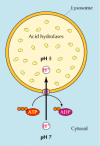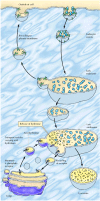Organelle That Contains Digestive Enzymes
Lysosomes are membrane-enclosed organelles that contain an array of enzymes capable of breaking downwardly all types of biological polymers—proteins, nucleic acids, carbohydrates, and lipids. Lysosomes function as the digestive system of the cell, serving both to degrade material taken upwardly from outside the jail cell and to assimilate obsolete components of the jail cell itself. In their simplest grade, lysosomes are visualized every bit dumbo spherical vacuoles, but they can brandish considerable variation in size and shape as a result of differences in the materials that have been taken up for digestion (Effigy nine.34). Lysosomes thus correspond morphologically diverse organelles defined by the common function of degrading intracellular material.

Figure 9.34
Electron micrograph of lysosomes and mitochondria in a mammalian cell. Lysosomes are indicated by arrows. (Visuals Unlimited/1000. Chiliad. Murti.)
Lysosomal Acid Hydrolases
Lysosomes incorporate nearly fifty unlike degradative enzymes that can hydrolyze proteins, Deoxyribonucleic acid, RNA, polysaccharides, and lipids. Mutations in the genes that encode these enzymes are responsible for more than thirty different human genetic diseases, which are called lysosomal storage diseases considering undegraded material accumulates within the lysosomes of affected individuals. Most of these diseases result from deficiencies in unmarried lysosomal enzymes. For instance, Gaucher's illness (the most common of these disorders) results from a mutation in the gene that encodes a lysosomal enzyme required for the breakdown of glycolipids. An intriguing exception is I-cell illness, which is acquired by a deficiency in the enzyme that catalyzes the first step in the tagging of lysosomal enzymes with mannose-6-phosphate in the Golgi apparatus (see Figure 9.25). The issue is a full general failure of lysosomal enzymes to be incorporated into lysosomes.
All of the lysosomal enzymes are acrid hydrolases, which are active at the acidic pH (about 5) that is maintained inside lysosomes but non at the neutral pH (about 7.ii) characteristic of the rest of the cytoplasm (Effigy 9.35). The requirement of these lysosomal hydrolases for acidic pH provides double protection confronting uncontrolled digestion of the contents of the cytosol; even if the lysosomal membrane were to pause downwards, the released acid hydrolases would be inactive at the neutral pH of the cytosol. To maintain their acidic internal pH, lysosomes must actively concentrate H+ ions (protons). This is accomplished past a proton pump in the lysosomal membrane, which actively transports protons into the lysosome from the cytosol. This pumping requires expenditure of energy in the form of ATP hydrolysis, since information technology maintains approximately a hundredfold higher H+ concentration inside the lysosome.

Figure ix.35
Organization of the lysosome. Lysosomes contain a variety of acid hydrolases that are active at the acidic pH maintained inside the lysosome, simply non at the neutral pH of the cytosol. The acidic internal pH of lysosomes results from the activeness of a proton (more than...)
Endocytosis and Lysosome Formation
One of the major functions of lysosomes is the digestion of material taken up from outside the cell by endocytosis, which is discussed in particular in Chapter 12. However, the role of lysosomes in the digestion of fabric taken upward by endocytosis relates not simply to the function of lysosomes but also to their formation. In particular, lysosomes are formed by the fusion of ship vesicles budded from the trans Golgi network with endosomes, which comprise molecules taken up past endocytosis at the plasma membrane.
The germination of lysosomes thus represents an intersection betwixt the secretory pathway, through which lysosomal proteins are processed, and the endocytic pathway, through which extracellular molecules are taken upwardly at the cell surface (Effigy 9.36). Material from outside the cell is taken upwards in clathrin-coated endocytic vesicles, which bud from the plasma membrane and and then fuse with early endosomes. Membrane components are then recycled to the plasma membrane (discussed in detail in Chapter 12) and the early endosomes gradually mature into tardily endosomes, which are the precursors to lysosomes. 1 of the important changes during endosome maturation is the lowering of the internal pH to about 5.5, which plays a key role in the commitment of lysosomal acrid hydrolases from the trans Golgi network.

Figure 9.36
Endocytosis and lysosome formation. Molecules are taken up from outside the jail cell in endocytic vesicles, which fuse with early endosomes. Membrane components are recycled equally the early endosomes mature into tardily endosomes. Transport vesicles carrying acrid (more...)
Every bit discussed earlier, acid hydrolases are targeted to lysosomes by mannose-6-phosphate residues, which are recognized past mannose-6-phosphate receptors in the trans Golgi network and packaged into clathrin-coated vesicles. Following removal of the clathrin coat, these send vesicles fuse with late endosomes, and the acidic internal pH causes the hydrolases to dissociate from the mannose-six-phosphate receptor (see Effigy nine.36). The hydrolases are thus released into the lumen of the endosome, while the receptors remain in the membrane and are somewhen recycled to the Golgi. Late endosomes then mature into lysosomes as they acquire a total complement of acrid hydrolases, which digest the molecules originally taken upwardly by endocytosis.
Phagocytosis and Autophagy
In add-on to degrading molecules taken up by endocytosis, lysosomes digest textile derived from ii other routes: phagocytosis and autophagy (Figure 9.37). In phagocytosis, specialized cells, such equally macrophages, take up and degrade large particles, including bacteria, jail cell droppings, and aged cells that need to exist eliminated from the body. Such large particles are taken up in phagocytic vacuoles (phagosomes), which so fuse with lysosomes, resulting in digestion of their contents. The lysosomes formed in this way (phagolysosomes) can be quite large and heterogeneous, since their size and shape is determined by the content of material that is beingness digested.

Figure ix.37
Lysosomes in phagocytosis and autophagy. In phagocytosis, large particles (such every bit bacteria) are taken upward into phagocytic vacuoles or phagosomes. In autophagy, internal organelles (such as mitochondria) are enclosed by membrane fragments from the ER, (more than...)
Lysosomes are too responsible for autophagy, the gradual turnover of the prison cell's own components. The start step of autophagy appears to be the enclosure of an organelle (e.g., a mitochondrion) in membrane derived from the ER. The resulting vesicle (an autophagosome) and then fuses with a lysosome, and its contents are digested (see Figure ix.37). As discussed in Chapter vii, autophagy is responsible for the gradual turnover of cytoplasmic organelles.
![]()
Box
Molecular Medicine: Gaucher's Disease.

Organelle That Contains Digestive Enzymes,
Source: https://www.ncbi.nlm.nih.gov/books/NBK9953/
Posted by: thompsonsonififf.blogspot.com


0 Response to "Organelle That Contains Digestive Enzymes"
Post a Comment